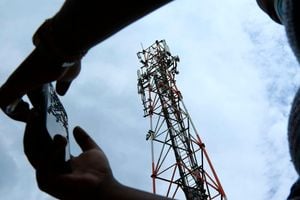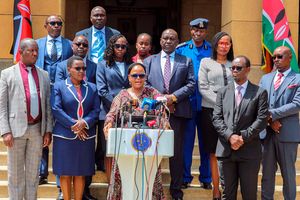
A telecommunications tower. For many years, residents of Endoinyo Erinka village in Narok South have struggled with persistent mobile phone network issues.
For many years, residents of Endoinyo Erinka village in Narok South have struggled with persistent mobile phone network issues.
The rural outpost, which neighbours Nkorinkori, is a corner of Kenya that seems untouched by modern advancements.
Residents here face a challenge rarely felt by those in urban centres—a complete lack of reliable communication.
This is even as Kenya has one of the best mobile penetration rates—and connectivity—in Africa.
As of June 2024, the Communications Authority of Kenya (CA) says there were 68.9 million mobile (SIM) subscriptions, translating to a penetration rate of 133.7 percent.
The East Africa Communications Organisation (EACO) report 2024 says Kenya has a 97 per cent mobile network coverage comparable to Uganda, Tanzania, and Rwanda.
Tucked away amidst the rugged terrain of Narok County and surrounded by wildlife such as lions, elephants, and buffaloes, the people of Endoinyo Erinka live in quiet isolation.
Silent crisis
This region, with its striking landscapes and rich cultural heritage, hides a silent crisis—a communication gap that takes a significant toll on the community.
The lack of mobile network coverage is affecting not only daily life but also education in the village.
Teachers at Endoinyo Erinka Comprehensive School face unique and dangerous challenges due to the absence of reliable mobile connectivity.
The school head teacher, Mr Charles Ombiro, says the consequences of this communication blackout have been deeply personal.
Last year, while preparing students for their final exams, Mr Ombiro only learnt of his brother’s death three days later due to the poor network.
“I had to focus on my students, but I didn’t know I had lost my brother until about three days later. It was heartbreaking,” says Mr Ombiro.
“The isolation that comes with living in a place where communication is a luxury is hard to explain. We feel abandoned and neglected,” he added.
The lack of communication infrastructure also affects the safety of residents, who face frequent dangers from wildlife encounters.
In the event of an emergency, such as illness, accident, or animal attack, residents have no way to quickly alert authorities or seek medical assistance.
The nearest health facility is 100 kilometres away, and without readily available transport services, patients are often transported by donkey, facing considerable health risks.
While Starlink, the satellite internet service, has provided some relief, it remains insufficient in resolving the broader issue of mobile phone connectivity.
Although the teachers can access Wi-Fi for research and lesson planning, they still struggle with the inability to make mobile calls, which is critical for timely updates and collaboration with colleagues.
“Even something as simple as receiving exam results is a challenge,” says Daniel Koonyo, another teacher at the school.
“We have to stay late in school, waiting for communication to trickle in, and sometimes we don’t even get it in real-time. It’s frustrating,” he revealed.
In an age driven by connectivity, the people of Endoinyo Erinka remain isolated, facing outdated means of communication.
The absence of mobile network coverage is not just an inconvenience; it is a matter of survival.
The residents continue to live with uncertainty, trekking to the nearest mountain to find a signal—a perilous journey often involving encounters with wild animals.
In 2020, Sapawoi Kumum, a resident of Endoinyo Erinka, reached out to Safaricom’s customer service, seeking help in bringing network services to the area.
However, despite the passage of several years, little progress has been made.
“It’s not that we don’t have options—it’s just that the options don’t reach us,” says Kumum. “People in cities have no idea how much we are missing. A simple phone call can save lives, but here, it’s a struggle. It feels like we’ve been forgotten.”
The emotional toll of isolation weighs heavily on the community. Teachers cannot collaborate effectively, students lack the necessary resources, and families face life-threatening delays during emergencies. The villagers remain resilient, continuing to seek ways to stay connected while hoping for better infrastructure.
Governance expert Mr Derrick Ombeo urges the government and private sector to take responsibility and address this critical gap.
“The residents of Endoinyo Erinka are also Kenyans and deserve access to services enjoyed by everyone else. I especially appeal to Safaricom and Airtel to install proper communication infrastructure in the area,” he says.
Until then, the residents will continue their uphill battle—both figuratively and literally—climbing mountains to connect with the outside world, all while facing the dangers of their wild surroundings.










